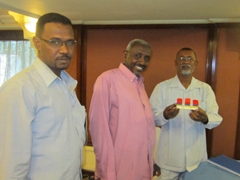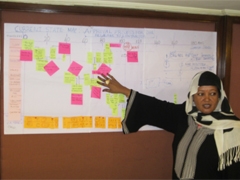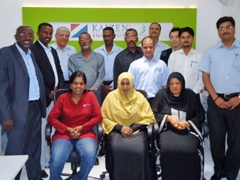- Home
- Technical Cooperation Projects
- Index of Countries
- Africa
- Sudan
- Capacity Development Project for Provision of the Services for Basic Human Needs in Kassala
- Project News
- Kassala meets Kaizen in India: Third country training in India
Project News
2012-07-31
Kassala meets Kaizen in India: Third country training in India
 Block game (Logo) practice: The trainees were given a photo of the shape made by blocks and requested to recreate precisely. In order to recreate precisely and faster, the “process” is crucial. After they tried at first by themselves, they learned how to speed up the work by 5S, dividing the blocks in red, blue and yellow.
Block game (Logo) practice: The trainees were given a photo of the shape made by blocks and requested to recreate precisely. In order to recreate precisely and faster, the “process” is crucial. After they tried at first by themselves, they learned how to speed up the work by 5S, dividing the blocks in red, blue and yellow.
Capacity Development Project for Provision of the Services for Basic Human Needs in Kassala (K-TOP) supports State Government's capacity development. One of the focus activities is the operational improvement of daily government business through Kaizen. K-TOP conducted the training on Kaizen offered by Kaizen Institute in Pune, India, as a succeeding program of the training in Japan in the first year, Kaizen Institute, which has a branch in Japan, is an international Kaizen consultant with its headquarter in Switzerland. Especially, Indian branch has a rich experience of technical assistance of the public sector in African countries. The Kassala Kaizen TOT (Training of Trainers) Team led by Director General of State Ministry of Finance and Director General of Directorate of Planning and Development (DPD) received the training for two weeks in the Institute, from 14th to 28th June, 2012.
Kaizen is originally developed in the manufacturing sector where Kaizen activities are used to improve operations and remove waste. Kaizen is also applied in the service sector including government, but applying Kaizen training for the government sector requires some invention since many training on Kaizen is based on learning from private manufacturing sector.
The facilitators of Kaizen Institute began its training with emphasizing "change of the way of thinking". The change includes introducing customer orientation in the government service by stressing "the next process is a customer". This means the officer should recognise the next desk where the documents is going to be circulated should be considered as a customer, and he/she needs to improve their business operation by removing waste and stress of "customers". Also the facilitators taught “No Problem is the Problem” to the government staffs which are usually satisfied with the status quo, to teach how to find and analyse problems.
The final highlight of the training was a training of process mapping. The process mapping literally maps each process of one task by disentangling the task by visualizing who do what and how long. By doing that, the participants could collectively discuss and analyse Muda (waste), Muri (strain) and Mura (inconsistency) which have to be improved in the process. The exercise took the example of an actual payment procedure of DPD to reduce the process time. After coming back to Kassala, DPD implemented some of the easy-to-implement activities by changing order of the procedure and layout of the office to reduce the payment process.
The training in Kaizen Institute includes many games during the course. The trainees enjoyed playing with a loop rope to make star-shape, and plastic blocks. When I saw this first, I felt uneasy because I could not understand the meaning of the high ranked officers of Kassala to come over to India to play games. However, the loop rope game teaches the importance of team building and planning, and the block game gave lessons on process and 5S, especially sorting. These games are real learning experiences. The effect of leaning experience has strengthened the extent of understanding dramatically and the satisfaction of trainees is very high. After they come back from India, the state government led by the trainees initiated the continuous Kaizen activities. Actually, I found out that I, who felt uneasy to playing games in the course, was the one who needs real change of the way of thinking.
 Process Mapping: It is a method which visualizes the workflow by putting the person in charge along the vertical line and the time along the horizontal line. Indicate the process by yellow and emphasize Muda (strain) by red tags.
Process Mapping: It is a method which visualizes the workflow by putting the person in charge along the vertical line and the time along the horizontal line. Indicate the process by yellow and emphasize Muda (strain) by red tags.
 Trainees and lecturers of Kaizen Institute
Trainees and lecturers of Kaizen Institute
(Reported by Mr. Retsu Hagiwara, JICA Expert on Local Administration / Public Financial Management)
- About JICA
- News & Features
- Countries & Regions
- Our Work
- Thematic Issues
- Types of Assistance
- Partnerships with Other Development Partners
- Climate Change / Environmental and Social Considerations
- Evaluations
- Compliance and Anti-corruption
- Science and Technology Cooperation on Global Issues
- Research
- JICA Development Studies Program / JICA Chair
- Support for the Acceptance of Foreign HRs / Multicultural and Inclusive Community
- Publications
- Investor Relations
